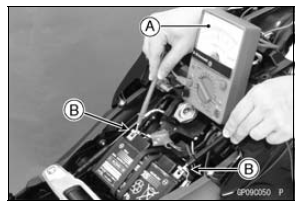

Special Tool - Hand Tester: 57001-1394
Charging Voltage 

If the charging voltage is kept between the values given in the table, the charging system is considered to be working normally.
If the charging voltage is much higher than the values specified in the table, the regulator/rectifier is defective or the regulator/rectifier leads are loose or open.
If the charging voltage does not rise as the engine speed increases, then the regulator/rectifier is defective or the alternator output is insufficient for the loads. Check the alternator and regulator/rectifier to determine which part is defective.
 Alternator Rotor Installation
Alternator Rotor Installation Alternator Inspection
Alternator InspectionTiming Rotor Installation
Install the timing rotor [A] on the crankshaft [B] with their
teeth [C] aligned.
Holding the timing rotor with the flywheel & pulley holder
and tighten the bolt.
Torque - Timing Rotor Bolt: 39 N·m (4.0 kgf·m, 29 ft·lb)
Special Tool - Flywheel & Pulley Holder: 57001-1605
I ...
Compression Damping Force Adjustment
There are two adjustments you can make to the compression
damping force.
High Speed Compression Damping Adjuster [A]
Low Speed Compression Damping Adjuster [B]
To adjust the high speed compression damping force, turn
the outside damping adjuster with a wrench to the desired
position ...
Thermostat Removal
Remove:
Fuel Tank (see Fuel Tank Removal in the Fuel System
(DFI) chapter)
Air Cleaner Housing (see Air Cleaner Housing Removal
in the Fuel System (DFI) chapter)
Throttle Body Assy (see Throttle Body Assy Removal in
the Fuel System (DFI) chapter)
Throttle Body Assy Holder Clamp [A]
...